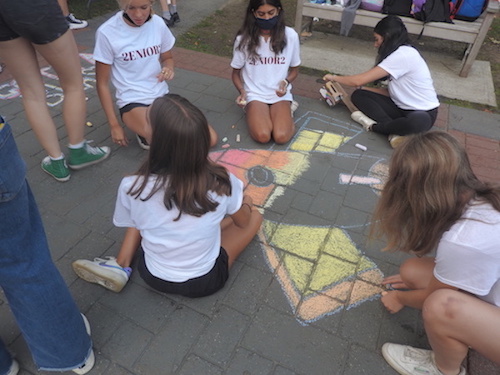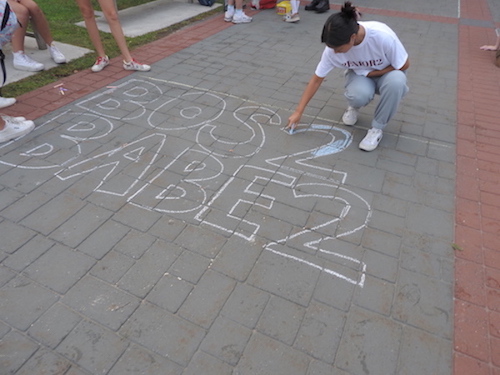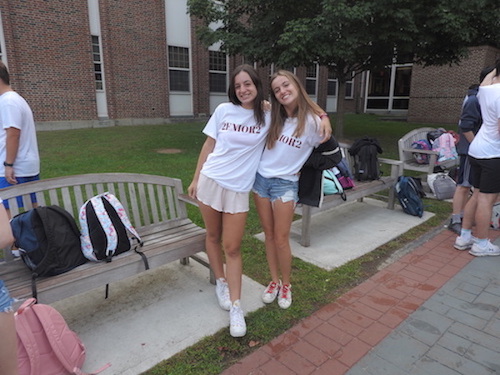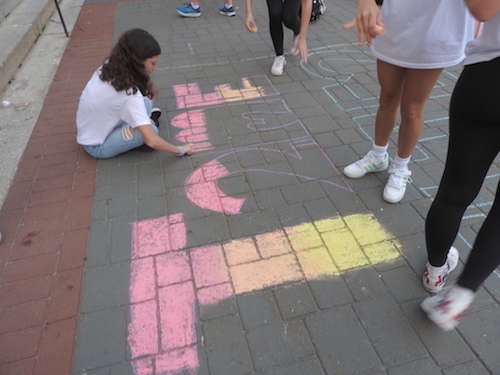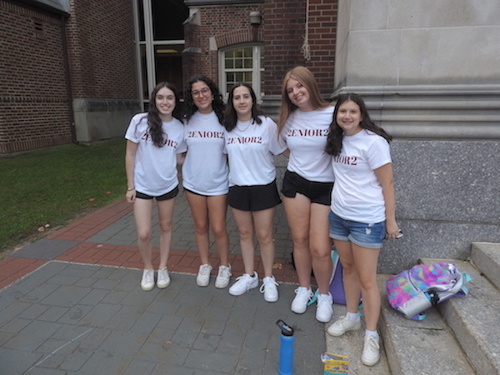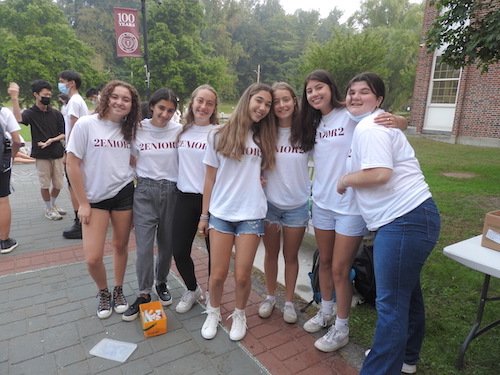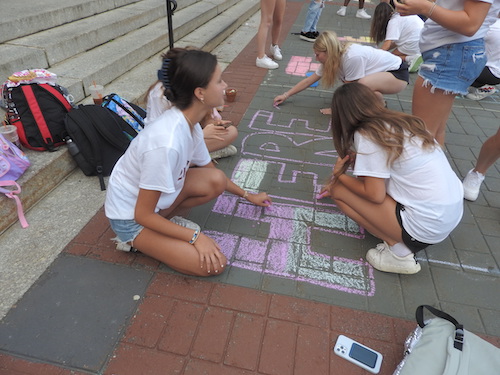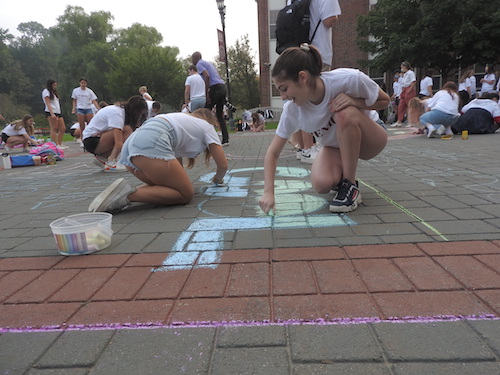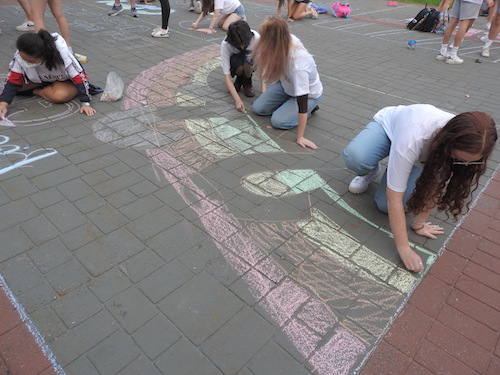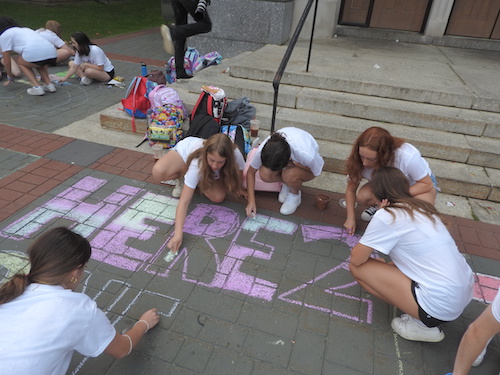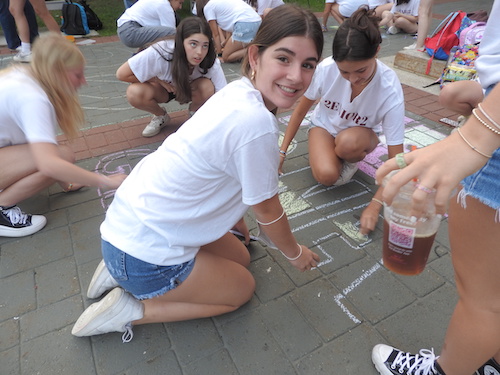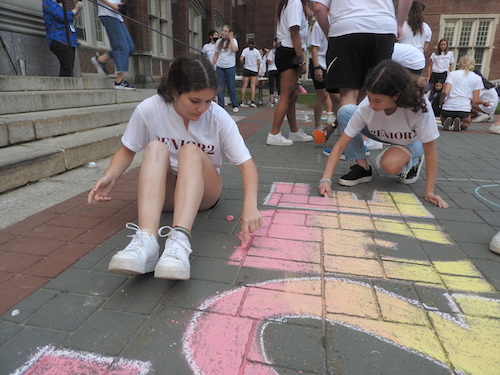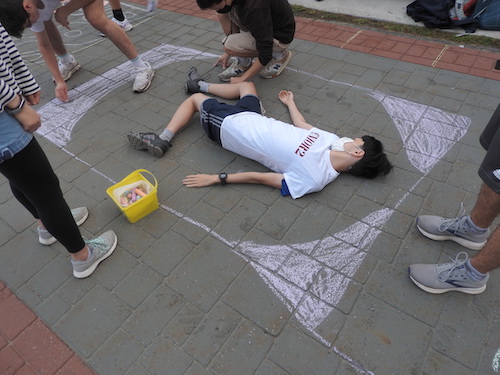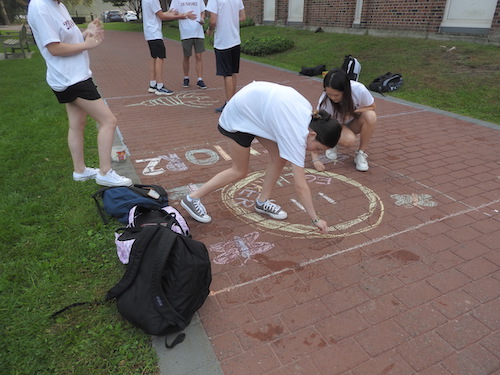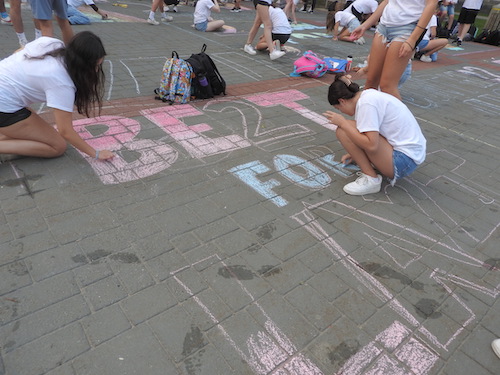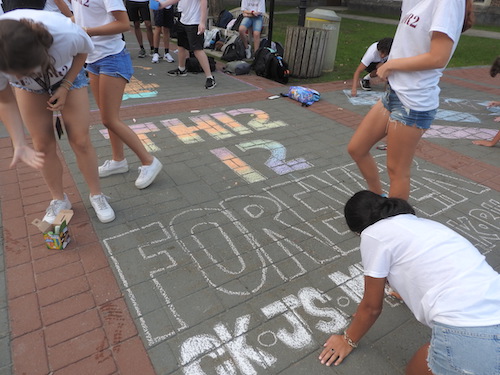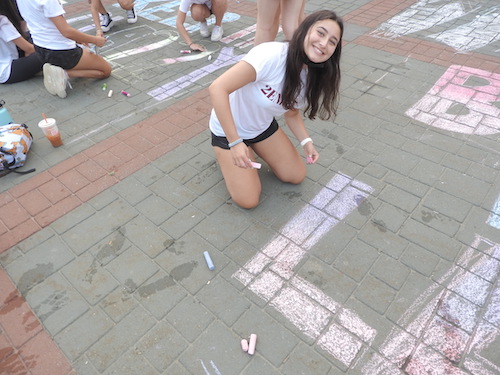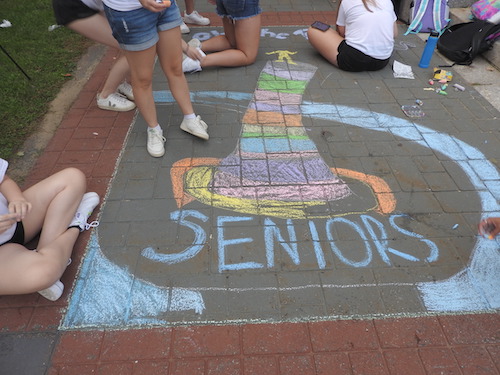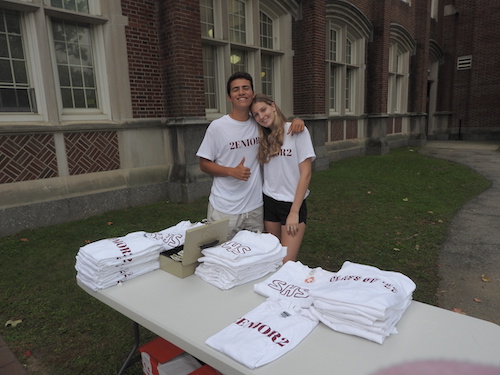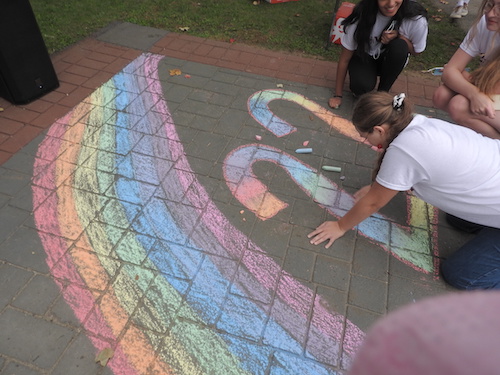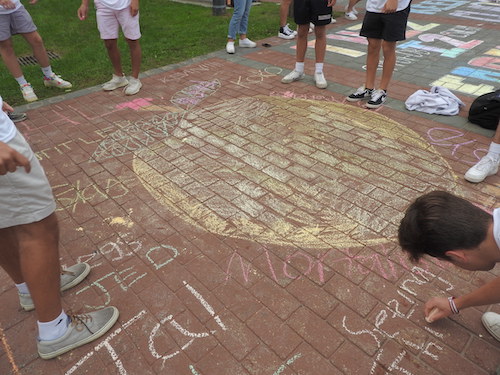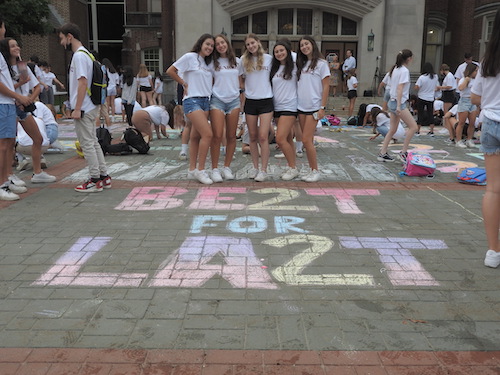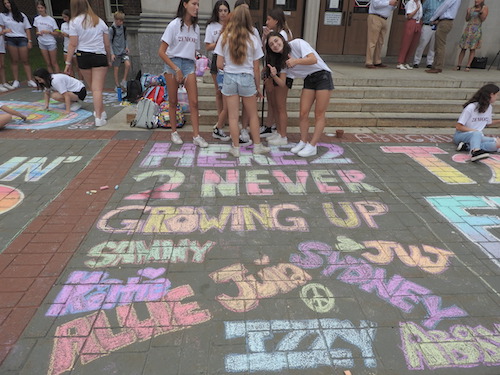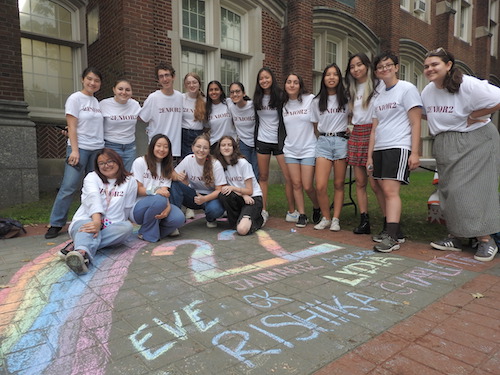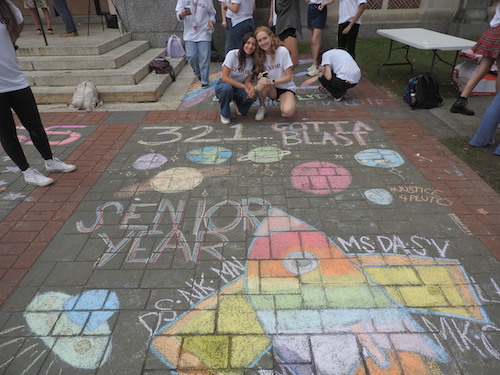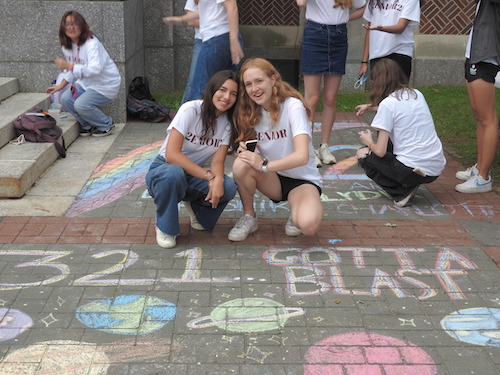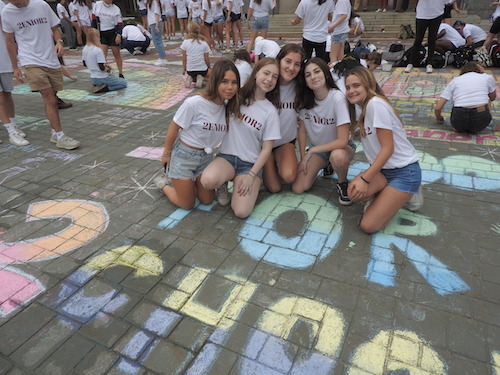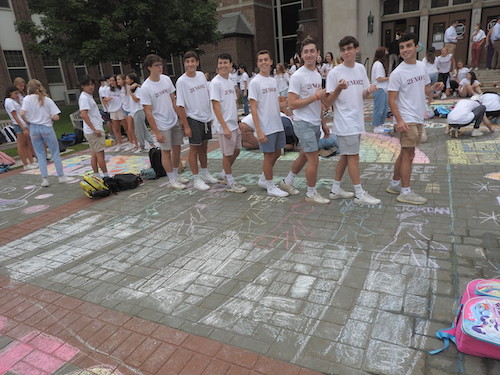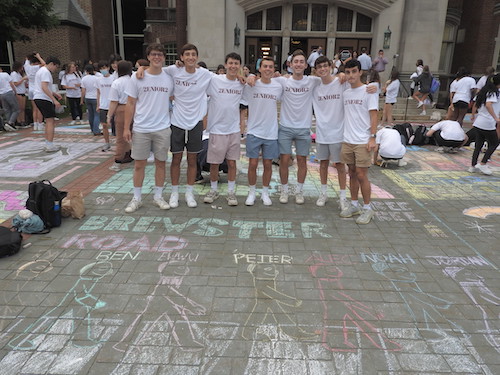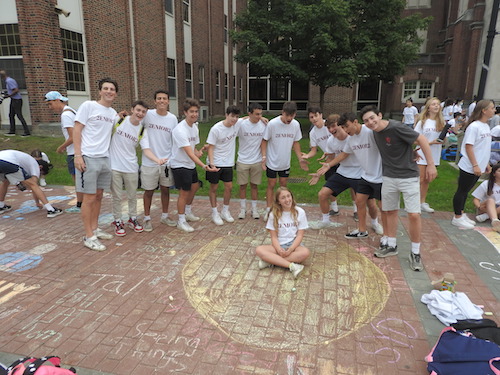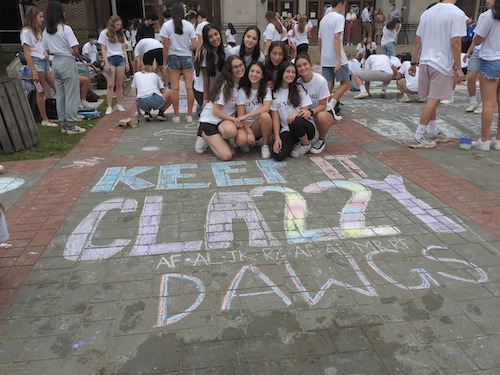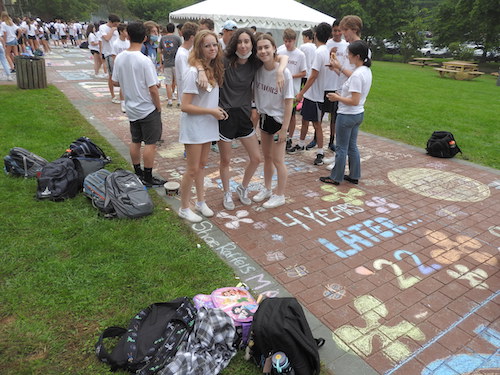Scarsdale Boys’ Soccer Secures Semifinal Date With Arlington
- Details
- Written by: Adam Katcher
- Hits: 2401
 Third-seed Scarsdale punched their ticket to the semifinals in front of a large crowd following a 3-0 quarterfinal victory over sixth-seed North Rockland.After an excellent 11-2-2 regular season for the Scarsdale Boys’ Varsity A Soccer Team, which included securing a League I – B title thanks to a Senior-Day victory over Mamaroneck, the Raiders had to forget about the thrill of the victory over the Tigers to turn their focus to the playoffs. The first-round clash against 14th seed Ketcham on October 21st (Scarsdale the third seed) appeared to be an easy game for Scarsdale at face value. Nonetheless, the Raiders needed to take care of business, and they did so with an impressive, albeit expected, 4-1 victory.
Third-seed Scarsdale punched their ticket to the semifinals in front of a large crowd following a 3-0 quarterfinal victory over sixth-seed North Rockland.After an excellent 11-2-2 regular season for the Scarsdale Boys’ Varsity A Soccer Team, which included securing a League I – B title thanks to a Senior-Day victory over Mamaroneck, the Raiders had to forget about the thrill of the victory over the Tigers to turn their focus to the playoffs. The first-round clash against 14th seed Ketcham on October 21st (Scarsdale the third seed) appeared to be an easy game for Scarsdale at face value. Nonetheless, the Raiders needed to take care of business, and they did so with an impressive, albeit expected, 4-1 victory.
In the quarterfinals, the Raiders came up against a more daunting opponent: sixth-seeded North Rockland. This was guaranteed to be the Raider’s final home game of the season because their first playoff opponent would be Arlington, a higher seed, with the home field advantage.
For the final game against North Rockland, the 12th man provided by the crowd helped give Scarsdale an extra edge throughout the tightly-contested affair.
In the first half both teams had a similar number of chances, with neither side really gaining an upper hand for a prolonged period. Goalkeeper Rowan Haffner did well to prevent a one-on-one breakaway for North Rockland from turning into a visitors’ lead, as Scarsdale’s co-captain rushed to the feet of the attacker to cut off an angle for a more dangerous shot.
A brutally honest halftime team talk was given, with coach Marcos Monteagudo and team seniors emphasizing the adjustments that needed to be made to give the Raiders the extra edge.
The second half took on a completely different complexion. Despite strong opposition, Scarsdale’s attack became freer flowing. The deadlock was broken thanks to a brilliant play by freshman Lorenzo Galeano. Senior Eli Gelblum played the ball to Galeano, who picked it up about 30 yards away from the net on the left-wing. His first touch directed him towards the box, giving him a one-on-one with one of the opponent’s center-backs, who subsequently fell over thanks to the Scarsdale winger’s fancy footwork. Galeano danced around the fallen player, cut the ball onto his right foot to evade two onrushing defenders, chopped the ball forward to get out of the reach of the back-on-his-feet center-back, and fired the ball into the bottom corner of the net, just beyond the goalkeeper’s outstretched right arm.
Galeano was once more involved when the Raiders doubled their lead. From a set-piece routine, Lorenzo assisted his brother Nico with a delicate ball over the top of the opposition’s high defensive line. Scarsdale’s third goal saw freshman Leo Khang whip in a pinpoint corner for an unmarked Gelblum, who still had a lot of work to do to remarkably tuck his volley into the top-left corner of the net. There was a slight bit of controversy late on as a North Rockland player was shown a red card for spitting at Scarsdale co-captain Kian Batliwalla.
The 3-0 final score in favor of the hosts was no less than what they deserved. The Raiders officially completed the season undefeated on their home fields (Quaker Ridge and Butler Field).
The Raiders are scheduled to kick off their semifinal clash at Arlington at 2 pm on October 27th. One of Scarsdale’s two losses this season came in their regular-season match at Arlington, with the team from Dutchess County emerging as 2-1 victors in that clash. The Raiders will be hoping to get their revenge to punch a ticket to the section finals on October 30th against the winner of the match between John Jay East Fishkill (first seed) and Mamaroneck (fifth seed). Regardless of what happens, this year’s Scarsdale Boys’ Varsity A Soccer Team has been the best team it has been in recent memory, so there is already so much to be proud of. Nonetheless, the players know its a win-or-go-home scenario and they will do everything they can to avoid tasting defeat with this team ever again.
Girls Varsity Tennis Team Starts the Season 3-0
- Details
- Written by: Joanne Wallenstein
- Hits: 3369
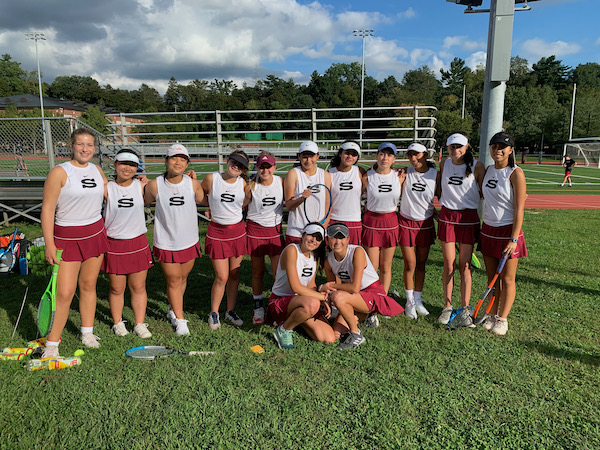 The SHS Girls Varsity A Tennis Team at their third match of the season.The talented Varsity A girls tennis team is off to a stunning start, barely dropping a set in the first three league matches of the year.
The SHS Girls Varsity A Tennis Team at their third match of the season.The talented Varsity A girls tennis team is off to a stunning start, barely dropping a set in the first three league matches of the year.
 Junior Natalie HuWith nine seniors graduating last year, this year’s team is a mix of 2 freshman, 3 sophomores, 4 juniors and 4 seniors. They are strong, skilled and strategic on the court.
Junior Natalie HuWith nine seniors graduating last year, this year’s team is a mix of 2 freshman, 3 sophomores, 4 juniors and 4 seniors. They are strong, skilled and strategic on the court.
The team’s captains are first singles player Natalie Hu and first doubles player Laura Mendez. Dressed in their team uniforms of maroon skirts and white and black T’s, they greeted rivals Mamaroneck for their third match of the season on Monday September 20, 2021.
After breezing by Fox Lane 7-0 and Ursuline 7-0, Coach Jennifer Roane said that the team expected a challenge from Mamaroneck who have always been among the most capable teams in the league. But they rose to the challenge and came away with impressive results.
At first singles, junior Natalie Hu played against Regan Aylett, a player she appeared to know. Hu came out strong, serving aces that her opponent couldn’t touch. She hit deep baseline shots, wonderful net shots and came off the court quickly with a 6-0, 6-0 win.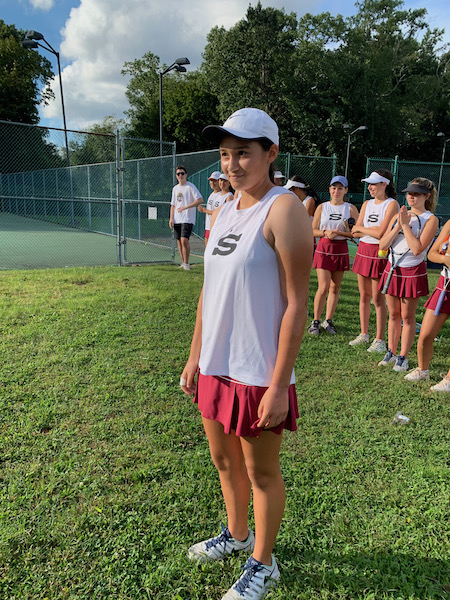 Freshman Giana Marks
Freshman Giana Marks
Only a freshman lefty Giana Marks plays second singles for the team. She is tough and consistent and I saw one 20 hit rally, before she bested her opponent 6-0, 6-1.
Playing third singles was junior Maya Cukierman, another aggressive hitter with a strong serve. She sent her opponent running from corner to corner, beating her 6-0, 6-0.
Playing first doubles for Scarsdale are senior Laura Mendez and junior Campbell Alin. In past years Mendez partnered with her sister, but now that her sister is in college, Laura has a new teammate. They played Mamaroneck’s Annabelle Reddy and Ann Donoghue and won 6-4, 6-3.
At second doubles is the powerful team of sophomore Maya Vora and Yelena Sahakyan. They hit deep shots to the baseline and triumphed 6-1, 6-2.
In third doubles Madison Lee was paired with Lara Wellen. We couldn’t see too much of that match from the sidelines but saw Lee hit a beautiful down the line backhand, passing her opponent at the net. The third doubles team dominated their match 6-2, 6-1.
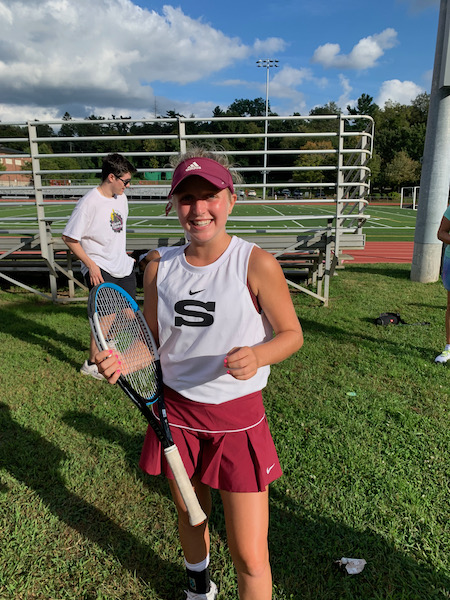 Maya CukiermanThe fourth doubles team of Natasha Pereira and Kay Cottrell had to wait until Natalie Hu was off the court. They came away 6-3, 6-4.
Maya CukiermanThe fourth doubles team of Natasha Pereira and Kay Cottrell had to wait until Natalie Hu was off the court. They came away 6-3, 6-4.
New this year, if the team qualifies for the states, the entire team will go, not individual players. The way they are playing now, they should have a good chance of competing.
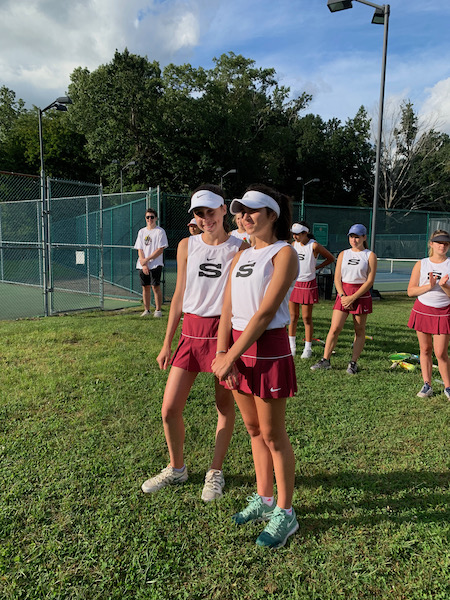 Campbell Alin and Laura Mendez
Campbell Alin and Laura Mendez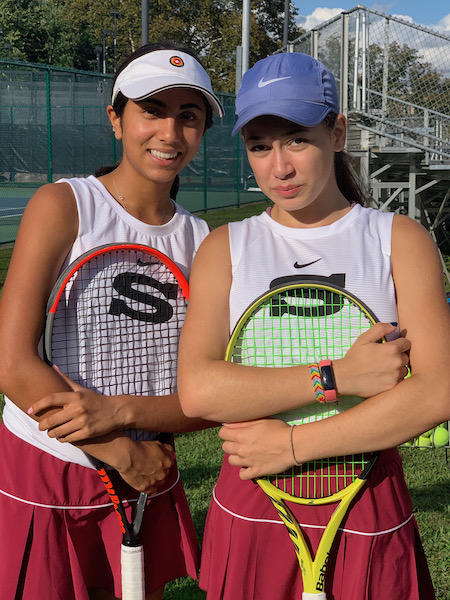 Maya Vora and Yelena Sahakyan.
Maya Vora and Yelena Sahakyan.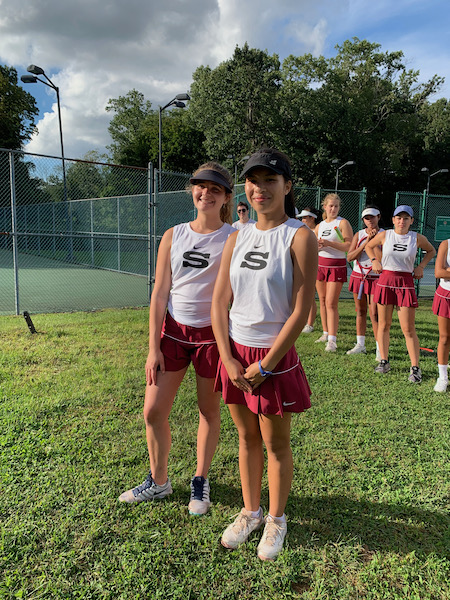 Lara Wellen and Madison Lee
Lara Wellen and Madison Lee Natasha Pereira and Kay Cottrell
Natasha Pereira and Kay Cottrell
Seniors Chalk It Up
- Details
- Hits: 2852
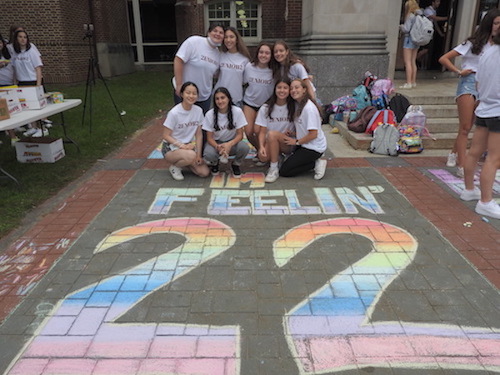
Each group chose an area for their chalk art. Each piece was intricate and thought out, and seniors used different colors, blended the chalk with their hands, and included clever phrases and pictures. Many of the phrases incorporated the class graduation year, 22 (2022). Some phrases included "Be2t For La2t" and "Keep it Cla22y". The event was a great teamwork activity to launch the senior’s last year in Scarsdale.
See photos from the event below:
Photos by Sophia Albert
Soccer Team Dodges Ida to Play Season Opener
- Details
- Written by: Adam Katcher
- Hits: 1769
 Two scrimmages in a row. Two quickfire goals to start both matches. Two more days until the opening match. The Varsity A soccer team, after a few strong training sessions following tryouts, wasted no time getting up to match-fitness ahead of the 2021 season. Preseason friendlies against Eastchester, North Rockland, and Iona Prep were lined up, but only the first two matches were able to be played.
Two scrimmages in a row. Two quickfire goals to start both matches. Two more days until the opening match. The Varsity A soccer team, after a few strong training sessions following tryouts, wasted no time getting up to match-fitness ahead of the 2021 season. Preseason friendlies against Eastchester, North Rockland, and Iona Prep were lined up, but only the first two matches were able to be played.
The Monday match at Eastchester and the Tuesday clash at Butler Field, despite their less-competitive-than-usual nature, showed there are plenty of goals in this Raiders team, finding the back of the net six total times across the two matches. Waking up on Wednesday, the team was prepared to play their final preseason match ahead of Friday’s season opener 30 miles away against Mahopac.
The remnants of Hurricane Ida proved to be its own type of storm. The wind came but did not roar, whereas the rain gradually started to come down at an intensity with which the soccer team approaches every match. By the time the school day ended on Wednesday, so too did the hopes of playing that third scrimmage. The onslaught of rain led to unplayable conditions, though that was just the beginning.
From Wednesday evening to Thursday morning, streets turned into rivers; fields turned into lakes; the final practice scheduled for Thursday before the season opener was cancelled. Thus, the Raiders had to enter their season opener following two days apart from the team. And, even though two days does not seem like much, fine margins such as missing extra days of practice can be decisive over the course of a season where the games come thick and fast.
On Friday, the team embarked on the nearly-hour-long bus ride up to Mahopac. The Raiders showed up over one hour early, so they took to the grass fields on the side of the main stadium to warm up, settle nerves, and get the blood flowing.
With 15 seniors on the team and 17 returning players from last season, a sense of a strong bond throughout the team was not difficult to forge. Even so, keeping that close-knit mentality once the starting whistle blows is not an easy task. Nonetheless, the Raiders were able to do so admirably.
Despite the match ending 0-0, it was clear that the Scarsdale team had a tremendous understanding of each other. Intricate attacking runs were made. Players knew where their teammates were at all times. Possession was dominated by the Raiders. Mahopac touches on the ball were few and far between. The opposition post was rattled and their goalie was forced into making a few spectacular saves to prevent Scarsdale from taking a victory back home. Nonetheless, it was clear the Raiders were the dominant side. Mahopac rarely, if at all, caused any trouble for a composed Rowan Haffner in the Scarsdale goal.
Even though the high school game does not have the analytics to give an exact statistic for possession, if possession percentages were calculated, they would likely show that Scarsdale had the ball for upwards of 75-80% of the match.
Senior midfielder Eli Gelblum echoed this notion, saying, “I think the team was both moving the ball well and pressing nicely as a unit. Countless times, we worked together to force a bad pass or win the ball back, something that we should definitely work to continue doing.”
 He also emphasized the importance of not only improving finishing technique, but also having an “even greater hunger” to score.
He also emphasized the importance of not only improving finishing technique, but also having an “even greater hunger” to score.
Gelblum also sees the togetherness within the squad, stating, “The chemistry on our team is amazing, and it shows on the field in the form of our great communication and overall cohesive play.”
The result of a tie was not ideal, though repeating strong, united performances will yield victories if there is just that extra clinical edge to attacking moves. However, do not be surprised in the slightest if the goal-scoring woes from the season opener briskly become an anomalous memory. The chemistry that flows within the team makes for an exciting season to come, with little blips able to be remedied in training.
Board Forms Subcommittee to Make Recommendations on Policies for Virtual Public Comments at School Board Meetings
- Details
- Written by: Joanne Wallenstein
- Hits: 3014
 One of the unexpected outcomes of the COVID crisis was the transition of public meetings from in-person to virtual, and the ability of the public to participate and comment remotely. Though this clearly increased public involvement, it also lengthened the meetings, with some Board meetings extending late into the night.
One of the unexpected outcomes of the COVID crisis was the transition of public meetings from in-person to virtual, and the ability of the public to participate and comment remotely. Though this clearly increased public involvement, it also lengthened the meetings, with some Board meetings extending late into the night.
Now that the Governor’s Executive order permitting virtual public meetings has expired, the Scarsdale Board of Education has reverted to its prior policies and virtual public comments are no longer allowed.
At the Board’s August 19 meeting both the League of Women Voters and the Middle School’s PTA leadership read statements urging the Board to permit virtual public comments. They cited the benefits of receiving more feedback and facilitating “robust public engagement.” Allowing people to comment remotely made it possible for people who were unable to attend the meetings in person to be a part of the process.
Board President Karen Ceske addressed the issue and led a discussion about the board’s policy at the meeting. She explained that they had conferred with their attorney who said that four Board policies would need to be amended to permit virtual public comment.
She said “The Board recognizes its responsibility to hear and respond to public comments and therefore encourages public participation at board meetings. Members of the public have raised the issue of the board allowing for remote public comment at Board meetings. Last year’s board discussed and made an amendment to board policy on one aspect of public participation and that was time. In consulting with our attorney several board policies would need to be amended.”
Ceske recommended that this work be done by a board committee to address the topic of public comment. She asked the board if there was interest in looking at these policies to adapt them for remote public participation.
Several board members agreed to the idea of a committee, but Board member Ron Schulhof asked that virtual comments could be permitted until the new policies are adopted. Dr. Hagerman said Board policies now prohibit this but the board can elect to suspend its own policies at a board meeting. He suggested adding the item to the agenda at the September 20, 2021 meeting and voting in the first half of the meeting to allow virtual public comment during the second public comments period at that meeting.
After considerable discussion the Board decided to form a board subcommittee to make recommendations to amend the policy, and Karen Ceske, Ron Schulholf and Jessica Resnick-Ault agreed to serve on it.
For the next meeting, they agreed to add the item to their agenda which would allow them to suspend the usual rules for that meeting only. If it passes, they will permit virtual public comment during the second half of that meeting.
Here are statements from the Scarsdale Middle School PTA Executive Committee and the Board of Directors of the League of Women Voters of Scarsdale advocating for virtual public comments.
Scarsdale Middle School PTA Executive Committee
The Scarsdale Middle School PTA Executive Committee (“SMS PTA EC”) strongly encourages the Board of Education (the “Board”) to allow remote public comment during the “Hearing from Those Present” section of its meetings.
The SMS PTA EC believes that robust, active and diverse public engagement and participation are essential to the Board’s process. In the 2020-21 school year, the incorporation of remote public comment further expanded community engagement on district issues.
The restoration of remote public comment would allow middle school parents, who may be unable to attend the Board’s evening meetings in-person, to more fully engage in district issues and publicly participate in meetings. The SMS PTA EC hopes that the Board reinstates remote public comment in order to increase accessibility and to hear from a more diverse group of voices.
Sincerely,
The Scarsdale Middle School PTA Executive Committee
Leah Dembitzer, President
Deb Lichtenstein, President Elect
Ophira Cukierman, Treasurer
Sam Carter, Secretary
Yi Yang, VP Membership and Directory
Stephanie Klingsberg, VP Programming
Lori Harrison, VP School Events and Initiatives
League of Women Voters of Scarsdale
I am Alissa Baum President of the League of Women Voters of Scarsdale, and I am speaking on behalf of the League Board of Directors.
The League’s position is that the Open Meeting Law allows remote public comment.
As the League stated publicly on June 21, 2021: "One of the League’s central missions is to promote the public’s active participation in government. The League has recognized and supported the School Board’s efforts to increase accessibility to the community through its coffees, listening sessions, and attendance at community events. Maintaining virtual public comment is one more avenue through which the School Board can broaden the public’s access to and participation in School Board meetings."
Furthermore, the League has continuously advocated that a more complete picture of community feedback, combined with relevant expert opinions and research, will serve to enhance Board decisions on complex issues and their implementation. This will then serve to facilitate community understanding and appreciation of Scarsdale schools. Remote public comment is a novel method of outreach discovered during the past 18 months that serves that end.
We understand that the advisory opinion recently issued by New York State’s Committee on Open Government makes clear that government officials, such as school board members, can participate in public meetings by video conference so long as certain statutory requirements are met. That advisory opinion does not prohibit virtual public comment.
The advisory opinion explains that the “fundamental premise of the Open Meetings Law is that any person who is interested in the deliberations of a public body is permitted to view and listen to such deliberations as they occur.” Thus, the advisory opinion finds that, to fulfill this premise, the public must be able to view a public meeting “at any site” at which a Board member is participating.
With regard to the participation of those who are not Board members, the advisory opinion states that, “the Open Meetings Law does not prohibit a public body from permitting invited guests (i.e., anyone who is not a member of the public body, but who has been asked to actively participate in the meeting) to speak or testify using a remote access platform."
The School Board has the right to invite anyone, including the public, to speak at a Board meeting using a remote access platform. In today’s meeting, it is simply choosing not to do so. This is counter to the very essence of the Open Meetings Law, which seeks to ensure robust public engagement with elected bodies. It is also counter to the support of public engagement to which the League subscribes and defends. It defies basic logic to allow Board Members to comment virtually but not the public. The League Board once again respectfully requests that the Board reconsider its decision denying the public the opportunity to comment at meetings virtually.










